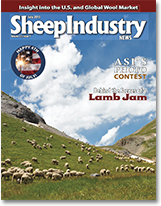To View the July 2013 Digial Issue — Click Here
Consumers Eager to Learn About Our Industry
Clint Krebs, ASI President
Welcome to the month of July, which for many of you is the beginning of the fair, Jackpot and show circuit. It is hard for me to know for sure, but from what I have seen and learned in my travels, the majority of the 80,000 plus sheep producers across the United States are raising sheep just for the opportunity to participate in these kinds of activities. I would like to say that the American Sheep Industry Association (ASI) works very hard to make sure we represent this large segment of our industry; however, I am not hearing from many of the producers who participate in the show segment. I would like to hear what you have to say. In my opinion, there is a whole lot more to showing sheep than if your lamb wins or how it places, it is a great social event and it gives the people participating an opportunity to be ambassadors for the entire industry.
This show sheep segment, as an ambassador role, can be very beneficial to those of us who raise sheep in a more commercial setting. I know producers who have raised lambs their entire life and have never had the opportunity to talk to a consumer, the ultimate buyer of lamb. The shows and fairs provide one of the few arenas where a producer, who feeds, doctors and takes care of a lamb comes into contact with someone who might be a customer or a potential customer of lamb. I would encourage those showing sheep to be very mindful of this interface when putting your sheep on public display or when talking to non-producers. The impression you leave with that customer or potential customer of lamb will last a very long time, and in reality, they will spread their opinion to dozens of other people. So if it is a positive interface you will be helping all sheep producers, but if the interface comes off being negative, the results will be negative.
I have had many opportunities to visit with urban consumers, and they are eager to learn about how we raise and harvest our animals. I encourage everyone to educate themselves before the shows on how to answer their questions. From my experiences in talking to mainly the urban consumer, amongst the other questions, they will ask “how much or what do you feed your lamb,” and they will be interested in the welfare of the animal during the harvesting process. Some will be too intimidated to ask out right, but others will, and I have found not answering this tough question creates more anxiety than saying, “the lambs are rendered unconscious before they are slaughtered.” The consumer may not be able to tell you where the lamb chop comes from on your animal, but they do understand they cannot eat the chop with the wool still on it.
We will soon be having ASI’s summer board meeting in Michigan to prepare next year’s budget. I certainly am looking forward to visiting this area of the country where sheep numbers are growing and the enthusiasm of the producers is very high. Maybe we can learn something from their positive attitude which will work in other areas of the country.
A couple of years ago I was in Nashville, Tenn., and I learned that when the lead female singer of a Nashville Honky-Tonk asks you to come up and help the band with their next song, she really doesn’t want to hear you sing. In fact she might not even be able to tell the difference between what she thought was a cowboy and a sheepherder. When she asked me for proof of being a sheepherder I was forced to model my 100-percent wool, 18-micron base layer, which was very well received by the audience. In fact, I am sure I increased sales of American wool because the audience kept yelling more, more. Now if I could only remember the song she was singing.


